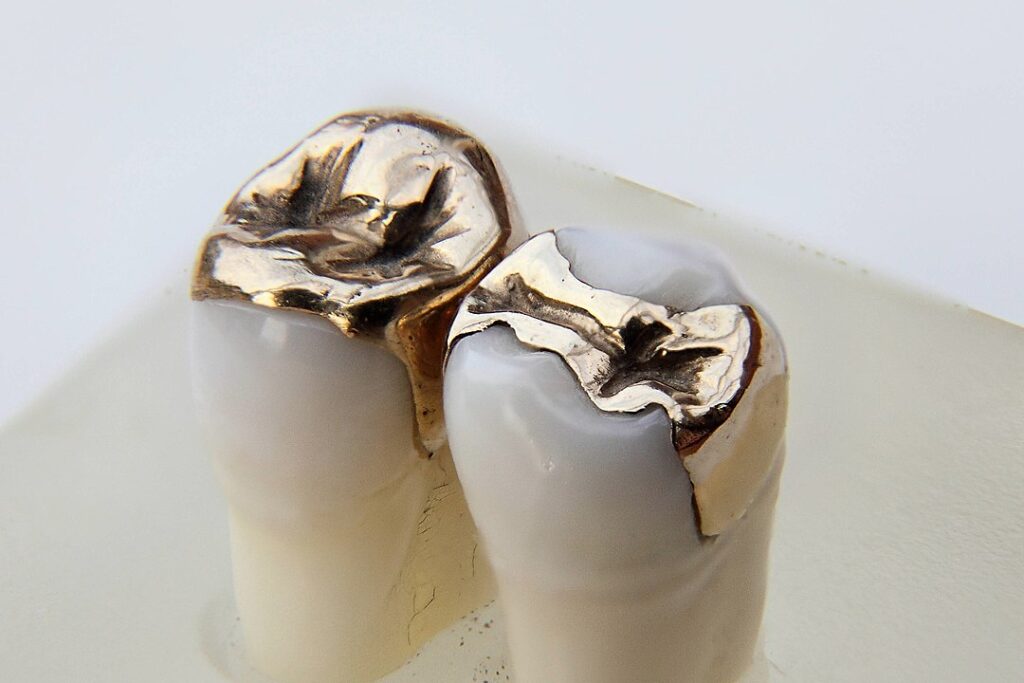Inlays & onlays
Inlays & onlays are used to restore the surface of a tooth. They are effective at repairing cavities, damages, and can enhance the strength of your teeth.If the tooth is damaged, or decayed, dentists will often try to save as much of the original tooth as they can. If the cavity or fracture is on top of the tooth, then an inlay or onlay can be inserted to repair the tooth.
What Are Dental Inlays & Onlays use for
Inlays and onlays are used for a few different purposes, they are either restorative or cosmetic:
- Repairs/increases resistance to cavities and damage.
- Change the shape and appearance of the tooth.
- Very strong and durable, they can last for decades.

Inlays
If the cavity or fracture is in the crevice of the tooth then the dentist can use an inlay. An in inlay is meant specifically for the crevices of the tooth and is not meant to cover the surface of the tooth.
Onlays
As the name suggests, an onlay is meant to “lay on” the surface of the tooth. If the cavity or damage covers more than the crevice of the tooth an onlay is used. If there is any decay or damage to the “cusps” of the teeth an onlay would be the best choice. Onlays are also significantly cheaper than crowns, if the damage or decay is significant enough, an onlay may not be effective, therefor a dentist may recommend a crown.
Inlay/Onlay Materials
Gold
Gold has been used for dental work for thousands of years, it is easy to manipulate, and very durable. Generally, gold is used for less visible teeth like the molars since it stands out easily and does not match the tooth’s color. It’s also an excellent choice for molars as it is one of the strongest, longest-lasting materials dentists use.
Pros
- Durable easy to use
- Low chance of breaking or fracture
- Stain-resistant
- Great for teeth that are not visible
Cons
- Does not match the color of the tooth
- Expensive
Ceramic (Porcelain)
Pros
- Strong and long-lasting
- Aesthetically pleasing
- Stain-resistant
Cons
- Not as flexible as gold
- Not as strong as gold
Composite Resin
Pros
Cons
- Weaker then gold
- Not stain-resistant
Inlays/Onlays – Procedure
Cavity/Filling Removal
If there is a cavity, a dentist will need to remove it before they can proceed. If there is a filling already there they will also need to take it out, this may happen to the filling being broken, or the tooth has even more decay or damage than the original filling was meant to fix.
Impression Of The Tooth
Inlays and onlays are custom-made to the patient’s specifications. The dental clinic will make an impression of the tooth so they can make the inlay/onlay fit perfectly, if the material used is porcelain, they will take note of the shade of the tooth so it can be matched.
Temporary Filling
The tooth will be vulnerable between the first appointment and the setting of the permanent filling. A dentist will use a temporary filling to protect your teeth in the meantime.
Placement Of The Inlay/Onlay
If the dentist appointment requires sedation, you should arrange for transportation to and from the dental clinic. Even if you feel fine after the procedure, the sedation effects can make it incredibly unsafe to handle a vehicle or other heavy-equipment
Aftercare Tips
Fillings require minimal aftercare and are fairly easy to keep clean when compared to other dental procedures. You will need to keep up your oral care and remember to focus on the tooth with the filling so it stays clean. You should also refrain from the physical activity without the use of a mouthguard. Older fillings can be knocked out more easily due to the age of the adhesive, a mouthguard will help prevent this. Ideally, you should also eat less sticky food so the filling does not get pulled out by it. If you get a composite resin filling, staying away from food and drinks that stain your teeth is also a good idea since composite resin fillings are not stained-resistant.
Checkups
Continue with your 6-month check-up routine, your dentist will monitor the health of the filling and will make sure it is secured in place. If you do switch dentists, you should ask for an x-ray and dental record release to the new clinic so the new dentist is aware of all your dental work beforehand.
